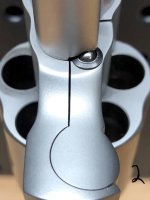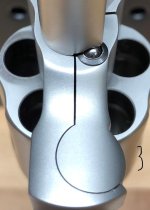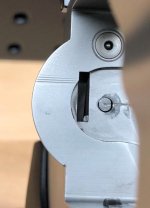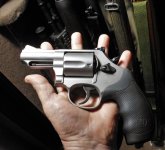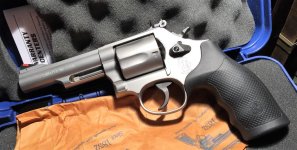And this is what you GET for buying a Smith and Wesson that rotates COUNTER-clockwise! So THERE!
What is causing the condition is the hand is bearing laterally against the ratchet applying lateral pressure to the cylinder and thus crane! Bear in mind that at full cock or full trigger pull, the hand is fully extended to a point where it is not "under" the drive portion of the ratchet, but is BESIDE the ratchet! This makes "timing" the action reasonable without super-precise fitting where the hand must index each chamber perfectly yet not hold the cylinder under pressure.
The FIX for your situation is EASY and much preferable to the opposite condition where the gun fails to "carry up!" The inside surface of the hand can be carefully (or indiscriminately ground if you're a risk taker!), honed down so it no longer applies so much lateral pressure when cocked. The key to doing such work is to remember there are 4 other locations on the ratchet where the hand finalizes its "carry up," so you must evaluate which shows the LEAST pressure and only hone to eliminate that ONE, accepting that some of the other four will still be under lateral pressure, or, you can proceed to step TWO and VERY carefully, hone - VERY carefully, the lateral contact surface of each ratchet to eliminate most, but not quite all, lateral force on the cylinder. S&W can do the work of course, and so too can any decent revolver smith.
Having material to remove is ALWAYS better than having excess space where the hand slips off the ratchet before full carry-up and is thus unable to consistently do so...much more likely on big, heavy cylinders such as the X-frames.
When an S&W is cocked, the hand is always trying to push the cylinder OUT of the frame an the only thing holding it in is the cylinder latch, and whatever spring-loaded ball detent such as on your (and my) M69! S&W made the center locking stud longer and uses stiffer springs in the cylinder latch and ejector star to prevent unlocking under hard recoil, but that's all that keeps things together when firing!
the tool marks have nothing at all to do with the cylinder issue.
BTW, the cylinder being "torqued" like that is certainly creating misalignment between chamber bore and forcing cone - but that's why we have forcing cones...to help transition the bullet into the barrel, but still, it's worth getting the issue corrected asap.

